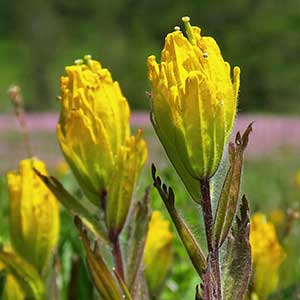Castilleja levisecta
Castilleja flava
golden Indian paintbrush, golden paintbrush
rustic paintbrush, yellow Indian paintbrush, yellow paintbrush
few to many, erect, ± decumbent or creeping at base, unbranched, sometimes branched, hairs spreading, medium length and long, soft, mixed with short stipitate-glandular ones.
several to many, erect or ascending, often grayish, unbranched or often branched distally, glabrate proximally or hairy, especially distally, rarely glabrous, hairs sparse, spreading to appressed, usually curly, ± short, soft, sometimes mixed with sparse, short stipitate-glandular ones.
green to purple or brown-tinged, linear-lanceolate proximally, oblong-ovate or -obovate distally, 0.8–5.2 cm, not fleshy, margins plane, distalmost sometimes ± wavy, involute, 3–7(–11)-lobed, apex obtuse;
lobes erect to ascending, linear to linear-spatulate, very short, toothlike, usually arising from distal 1/3 of blade, apex rounded.
often grayish or purplish, linear to narrowly lanceolate or narrowly oblong, (1–)2.5–5(–6.7) cm, not fleshy, margins plane or wavy, involute, deeply (0–)3–5(–7)-lobed, apex acute to acuminate;
lobes divaricate to spreading or ascending, linear, arising at or below mid length, apex acute to acuminate.
2.5–25 × 1–4 cm;
bracts bright yellow throughout, or proximally greenish, distally bright yellow, sometimes deep yellow-orange, especially with age, oblong, elliptic, or obtuse to ovate, (0–)5–9(–13)-lobed, sometimes wavy-margined;
lobes erect to ascending, oblong, short to medium length, arising above mid length, central lobe apex rounded, lateral ones rounded to acute.
3.5–20(–29) × 1–4 cm;
bracts pale green to pale yellow throughout, or proximally pale green to pale yellow, distally pale yellow to bright yellow, sometimes light orange, light red, or bright red, lanceolate to narrowly oblong or narrowly elliptic, slightly broader than leaves, usually 3–5-lobed;
lobes ± spreading, linear or narrowly lanceolate, short or long, proximal or all bracts arising near or below mid length, apex acute, sometimes narrowly obtuse.
straight or slightly curved, 17–28 mm;
tube 12–15 mm;
beak exserted, adaxially green or greenish yellow, 6–8 mm;
abaxial lip yellow or greenish, reduced, not inflated, 2–3 mm, 25–33(–50)% as long as beak;
teeth ascending to erect, yellow, 0.5–1.5 mm.
straight or ± curved, 13–30 mm;
tube 12–16 mm;
beak, sometimes abaxial lip, slightly to strongly exserted, corolla often curved and exserted through abaxial cleft;
beak adaxially green, (5–)6–12 mm;
abaxial lip green or yellow, reduced, exserted or more commonly visible in cleft in calyx, 1–3.5 mm, 20–33(–50)% as long as beak;
teeth ascending, green to yellow, 0.5–2 mm.
distally yellow, 13–22 mm;
abaxial and adaxial clefts 4–9.5 mm, 30–40% of calyx length, deeper than laterals, lateral 2.5–4.5 mm, ca. 25% of calyx length;
lobes linear to narrowly oblong or narrowly lanceolate, apex obtuse, sometimes rounded to acute.
proximally green, sometimes purple or pinkish, distally yellow to light orange, dull green, or colored as bracts, 11–28 mm;
abaxial and adaxial clefts 4–16(–17) mm, 30–60(–95)% of calyx length, deeper than laterals, lateral 0.5–7 mm, 4–30% of calyx length;
lobes linear to lanceolate or narrowly to broadly triangular, apex acute to acuminate.
= 24.
= 48.
Castilleja levisecta
Castilleja flava
Castilleja levisecta is listed as threatened in the United States and endangered in Canada, where it is extremely rare. Most of its grassland habitat has been altered by development in the Puget Trough, and there are historical stations in the metro areas of what are now Victoria, Portland, and Seattle. For several decades, C. levisecta was considered extirpated from Oregon. However, recent reintroduction programs in Oregon and Washington have been very successful at reestablishing this species at several sites in the Willamette Valley. The bright yellow inflorescences often gradually age to a golden yellow color, unique in the genus.
Castilleja levisecta is in the Center for Plant Conservation’s National Collection of Endangered Plants.
(Discussion copyrighted by Flora of North America; reprinted with permission.)
Varieties 2 (2 in the flora).
Both varieties of Castilleja flava are characteristic plants of sagebrush-dominated communities throughout its wide range, from valleys to moderate elevations in the mountains, sometimes reaching the lower subalpine. The species almost always occurs in close association with shrubby species of Artemisia.
(Discussion copyrighted by Flora of North America; reprinted with permission.)
1. Corolla beaks 5–12 mm, abaxial lips 1–2 mm; calyx abaxial clefts 8–16 mm, adaxial 4–8(–15.5) mm; n Great Basin, c Rocky Mountains. | var. flava |
1. Corolla beaks 5–8(–9.5) mm, abaxial lips (1.5–)2–3.5 mm; calyx abaxial and adaxial clefts subequal, (6–)7–13(–17) mm; mountains of ne Oregon to c Idaho. | var. rustica |


